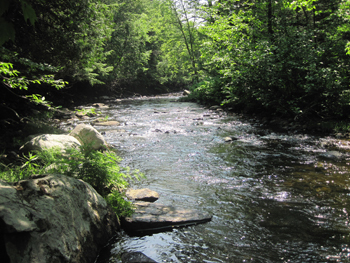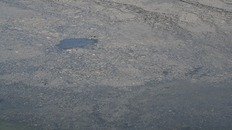APRIL 2024

Maine's water quality standards designate appropriate uses for waterbodies, such as recreation or fishing, and specify which criteria and antidegradation measures are in place to protect those uses.
The federal Clean Water Act §303(c)(1); 40 CFR Part 131.20 requires that states hold public hearings at least every three years (triennially) for the purpose of reviewing water quality standards and, as appropriate, modifying and developing standards. Maine Statute contains similar language in 38 M.R.S.§464.3.B. This process is known as the Triennial Review.
The Maine Department of Environmental Protection (the Department) is now embarking on a Triennial Review, which is expected to extend into 2026 for any required legislation. You are invited to submit proposals to the Department for changes to existing water quality standards, including the water quality classification of specific surface waters. Proposals for new standards may also be submitted.
Proposals are due by the close of business on Thursday, June 27, 2024, and should be submitted to TRComments.DEP@maine.gov.
To learn more about the Triennial Review, including how you can submit information to be considered, please use the following link to the Department’s web page dedicated to the triennial review.
https://www.maine.gov/dep/water/wqs/triennial-review.html.
Questions? Contact Susanne Meidel, 207-441-3612.
|
With the 130th Maine Legislature’s approval of Governor Mills’ The Maine Jobs & Recovery Plan, one-time funding in the amount of $3,000,000 has been allocated to the Small Community Grant (SCG) program. This funding was provided by the American Rescue Plan Act (APRA) of 2021 for the purpose of State Fiscal Recovery. SCG is administered by the Department of Environmental Protection (the Department). The total remaining funds will be expended in 2024.
Grants can be used to correct malfunctioning septic systems which directly or indirectly discharge sewage to waterbodies of the State, or are causing public health problems.
The Department is now accepting applications from municipalities for SCG program funding requests. Grant applications will be accepted throughout the year, but approval will depend on available funding. To be considered in the first round, applications must be submitted by April 15th, 2024, before 5pm. Grant applications, along with more information about the program, can be found on the Department’s website, https://www.maine.gov/dep/water/grants/scgp.html.
The first step to determine if municipalities qualify for SCG is to submit the grant application form, including Applicant Information, Application Description of Existing Conditions, and Discharge Field Report.
Please submit the Grant Application to Maine.CWSRF.Grants@maine.gov or by mail addressed to Robert Hartley, SCG Project Engineer, Bureau of Water Quality, 17 State House Station, Augusta, Maine 04333-0017, by April 15th, 2023, before 5pm. Applications submitted via email are preferred.
The Department will assess the applications and send out letters determining grant eligibility by May 10th, 2024.
If you have any questions about the process, please contact Robert Hartley, SCG Coordinator by email at Robert.W.Hartley@maine.gov or by phone at (207) 881-9490.
Bangor Testing Site Temporarily Closed
The Bangor wastewater exam testing site is temporarily closed. The Department is working with our partners to secure testing availability in the Bangor area.
Other locations where operators can take the wastewater exam include Auburn, Farmington, Portland, Presque Isle, South Portland, and Portsmouth, NH.
If you need to take a wastewater exam in the Bangor area, please contact Spring Connolly, certification@neiwpcc-jetcc.org for more information.
JETCC Presenting In-Person Collection System Training
JETCC is pleased to announce a 3-part, in-person Collection Systems training series that will be offered at several locations around the state.
The three courses are Jetting Nozzles & Pipe Cleaning, Intro to Jetting & Vacuuming in the Field, and Intro to Point Repairs in the Field. All classes are approved for 6 TCHs for both drinking water and wastewater operators. Jack Berry of Berry Consulting, along with other instructors, will be teaching the classes.
The dates, location and description of the classes are summarized below:
Jetting Nozzles & Pipe Cleaning Saco - April 2, Brunswick - April 3, Brewer - April 4
This class will focus on the fundamentals of jetting nozzles and pipe cleaning. Topics include:
- Understanding and recognizing the differences between nozzles
- Pressure and friction loss in jetting systems
- Hose specifications and requirements for different needs
- Flow and the effect of different nozzles on pumping demand and cleaning effectiveness
Attendees will have an opportunity to handle several different nozzles during class and participate in a demonstration with a jetting truck onsite.
Intro to Jetting & Vacuuming in the Field Biddeford - April 16, Brewer - April 18, Brunswick - April 24
This class will prepare attendees to get to work with pipe cleaning and vacuuming. The class will largely be held in the field with live demonstrations of jetting and vacuuming. Topics include: ·
Review of jetting and vacuuming systems and equipment · Preparing the jetting and vacuuming truck and review of operational checklists · Preparation of the work site and safe work zone requirements · In-field pipe cleaning and inspection with camera equipment.
Intro to Point Repairs in the Field Biddeford - April 23, Brewer - April 25, Brunswick - May 1
This training will help attendees learn how to install their own point repairs. Topics include:
- An introduction to point repair technique and materials
- Review of equipment and trailer setup used by local wastewater utilities to install their own point repairs
- Demonstration of installation of a point repair in a controlled environment
- Installation of a point repair in the field, including site preparation, division of tasks among staff, pipe inspection, and repair installation.
For more information go to www.jetcc.org or call 207-253-8020.
NEIWPCC Offers Management May Training Series
NEIWPCC is offering a Management May training series for operators, technicians, supervisors, and managers at all levels. The series is sponsored by NEIWPCC in conjunction with the EPA. This training can act as a refresher for managers and leaders while also acting as a great introduction for future leaders in the wastewater industry.
All sessions are 3 hours in length and taught by Bill Patenaude, who worked for many years with the RI DEM. The training sessions are accepted for Management TCHs for wastewater CEUs. The 3 sessions are described below.
Introduction to Management and Leadership - May 1, 2024. The course examines the different elements and overlap of both managing a team and leading it. Often used interchangeably, these terms describe different skillsets with different aims, even as they are employed within all levels of an organization.
Team Building in the Water Industry - May 8, 2024. Building a strong team of operators, engineers, technicians, and managers is essential for the smooth operation of your facility. This training examines group dynamics throughout and within all organizational functions. We will also discuss task-oriented teams deployed for short-term or ongoing purposes.
Basic Communications: Tips for Water and Wastewater Professionals – May 22, 2024. For much of their existence, wastewater utilities have made a massive effort to operate in plain sight, drawing as little attention as possible. Today, however, the landscape has changed. The public is more engaged than ever in what is happening at their local utility, and it is important for wastewater professionals to know how to communicate with them clearly.
Continuity of Operations: How to Manage Growing Challenges – May 29, 2024. With growing threats from cybercriminals, climate change, labor shortages, and other challenges, wastewater professionals have to expand their toolkits to ensure that their workplace does not fall victim to new challenges. Rather than examining these threats individually, this training will act as a practice session to build plans to respond to and recover from these threats.
For more information, visit www.neiwpcc.org.
Monthly Training Calendar and Training/Certification Resources.
The monthly training calendar, which lists training by not-for-profit organizations, is emailed to certified operators each month. It can be found at the DEP’s certification website https://www.maine.gov/dep/water/wwoperator/ under the Additional Materials section.
The NEIWPCC/JETCC website, https://jetcc.org/index.php provides information on signing up for an exam, training classes, and certification renewal. Contact Spring Conolly at certification@neiwpcc-jetcc.org or call 207-253-8020 for more information.
Copyrighted material. Used by permission of Triplepoint Environmental website: www.lagoons.com. The appearance of external hyperlinks does not constitute endorsement by the Maine Department of Environmental Protection of the linked web sites, or the information, products or services contained therein.

Spring is the time of the year when unmixed lagoons turn over, so it’s also the time of the year when operators (and local residents) are concerned about wastewater lagoon odor control. Although spring lagoon turnover and its accompanying odors may be normal and expected, that doesn’t mean they are tolerated. Learn what causes lagoons to turn over and what can be done to mitigate odor.
What causes lagoon turnover?
An unmixed wastewater lagoon will settle into layers, with denser, cooler water at the bottom and lighter, warmer water at the top. This is known as thermal stratification. In spring and fall, the change in ambient temperatures causes the layers to mix and eventually create a uniform temperature. As the layers begin to destratify and mix, the settled solids become resuspended and the odorous gases trapped at the bottom are released to the surface, a phenomenon called lagoon turnover. In a healthy, functional lagoon, this process should take about a week. In a well-aerated and mixed lagoon, it won’t happen at all.
What makes spring turnover and odors so severe?
Spring is usually the time of highest BOD loads in a wastewater lagoon. You’ve got the BOD that’s been stored over the winter, new influent BOD, and the BOD demands of the accumulated sludge at the bottom of the lagoon.
In the spring, increased sunlight warms the top layer of the lagoon, melting the surface ice and allowing sunlight to penetrate, creating convection currents. Gradually, with the sun’s warmth and wind, the entire lagoon reaches a uniform temperature and circulation increases.
Figure 1 – Sludge Turnover
|

This increased circulation disturbs the accumulated sludge and solids that have been lurking at the bottom of the lagoon and pushes them to the surface. This releases hydrogen sulfide (H2S), the stinky gas that is generated by anaerobic digestion.
The dislodging of the settled sludge and solids also results in benthal feedback or benthal release, which is when nutrients like nitrogen and inorganic materials like metals that have been trapped in the sludge get released back into the lagoon. Benthal feedback can cause ammonia levels in the lagoon to be higher than in the influent.
Once the temperature hits 50 degrees F or so, bacterial action begins in earnest and starts to consume all the BOD that’s been stored up over the winter. The problem is, aerobic BOD-eating bacteria need dissolved oxygen to work, and there just isn’t enough. In the spring, a wastewater lagoon can need as much as triple the usual amount of DO—as much as 5–6 lbs. of O2 per pound of influent BOD—to handle the increased load.
Problems Caused by Lagoon Turnover
Without sufficient DO, the bacteria resort to anaerobic digestion, which is a slow and smelly process. Sludge accumulates, odors linger, and effluent violations from undertreatment are likely, including:
-
Floating sludge: As the increasing sunlight and wind circulate the water, the solids settled at the bottom, which have been quietly anaerobically digesting, are churned up. The anaerobic digestion process releases gas as a byproduct, which becomes entrained in the sludge. Once dislodged, the gas trapped in the sludge causes it to rise from the bottom of the lagoon and float.
Figure 2 – Floating Sludge
|

-
Intense Odors: With the rising gas byproduct of anaerobic digestion, unpleasant lagoon odors are released into the atmosphere all at once. These odors, coupled with those of the floating sludge mat, are strong during lagoon turnover. If picked up by the wind, these odors will likely result in angry calls and a feature story in your local newspaper.
-
Lagoon Treatment Suffers: Lagoon turnover can be a sign that your lagoon is septic and is breaking down nutrients via anaerobic digestion. Expect a spike in effluent BOD, TSS, and other treatment parameters at some point in the near future if corrective action is not taken.
How to Prevent Spring Lagoon Odors
To prevent lagoon turnover, you need to combat the causes:
-
Increase circulation to prevent stratification: By continually circulating the water, the lagoon layers will never be able to fully stratify. With both a homogeneous lagoon water temperature and environment, no spring lagoon turnover will occur.
-
Increase dissolved oxygen levels to combat low DO: One of the easiest ways to do this is to add aeration to your lagoon. By maintaining an aerobic environment you will limit the production of noxious H2S gases.
-
Increase mixing to prevent sludge buildup on the bottom: Proper lagoon mixing limits sludge accumulation by keeping solids in the water column where they can break down aerobically and odor-free.
Mixing is a critical component of wastewater lagoon aeration, keeping oxygen distributed throughout the water column and preventing solids from settling as sludge. Lagoon aerators that combine efficient fine bubble aeration with coarse bubble mixing in a single portable unit is one way to eliminate floating sludge and odors.
|
1. BOD stands for
a. Biological Organic Demand
b. Biochemical Oxygen Demand
c. Biological Oxygen Deficient
d. Biochemical Organism Deficient
2. BOD is a measure of the
a. Oxygen necessary to biologically degrade organic material
b. Biodegradable of tardigrades
c. Decomposition rate
d. Release of energy, water, and carbon dioxide.
3. The BOD test required on most MEPDES permits takes
a. 5 hours
b. 2 days
c. 5 days
d. 30 days
4. BOD test bottles are typically
a. 3 mL
b. 30 mL
c. 300 mL
d. Depends on the sample dilution
5. Blanks are used for the BOD test to:
a. Check for contamination
b. Check the seed
c. Check for correct dilutions
d. Check for industrial wastes
6. Blanks for the BOD test contain
a. Dilution water and seed
b. Dilution water and the lowest sample level
c. Distilled water and GGA
d. Dilution water and nutrients
7. The glucose glutamic acid (GGA) standard should be prepared
a. The day before the test is run to allow acclimatization
b. When the 24-hr composite sampler is first set-up
c. Fresh, on the day of test set-up
d. Every 30 days to correspond with the DMR schedule
8. For BOD results to be valid, the DO depletion on day 5 must be
a. At least 1 mg/L from the initial DO, and greater than 2 mg/L remaining
b. At least 2 mg/L from the initial DO, and greater than 1 mg/L remaining
c. At least 5 mg/L from the initial DO, and greater than 2 mg/L remaining
d. Depends on the dilution levels
9. The initial DO of a 15 mL sample was 7.1 mg/L and the final DO after 5 days of incubation at 20 degrees C in a 300 mL sample bottle was 5.6 mg/L. What was the BOD in mg/L?
a. 1.5
b. 30
c. The test is not valid because the depletion is insufficient
d. The test is not valid because there is insufficient DO remaining
10. The initial DO of a 80 mL sample was 6.8 mg/L and the final DO after 5 days of incubation at 20 degrees C in a 300 mL sample bottle was 0.4 mg/L. What was the BOD in mg/L?
a. 6.4
b. 24
c. The test is not valid because the depletion is insufficient
d. The test is not valid because there is insufficient DO remaining
Answers:
1. (b.) Biochemical Oxygen Demand
2. (a.) Oxygen necessary to biologically degrade organic material
3. (c.) 5 days
4. (c.) 300 mL
5. (a.) Check for contamination
6. (d.) Dilution water and nutrients
7. (c.) Fresh, on the day of test set-up
8. (b.) At least 2 mg/L from the initial DO, and greater than 1 mg/L remaining
9. (c.) The test is not valid because the depletion is insufficient
7.1 mg/L – 5.6 mg/L = 1.5 mg/L
In order for a valid test, the depletion must be at least 2 mg/L
10. (d.) The test is not valid because there is insufficient DO remaining
At least 1 mg/L must be remaining in the sample for a valid test. Since there is only 0.4 mg/L DO remaining after 5 days, the test is invalid.
|